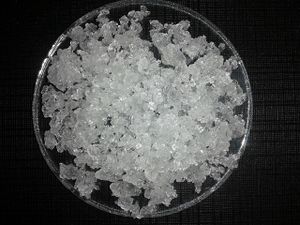Aluminium nitrate
 Aluminium nitrate nonahydrate sample
| |
| Names | |
|---|---|
| IUPAC name
Aluminium nitrate
| |
| Preferred IUPAC name
Aluminium nitrate | |
| Other names
Aluminium(III) nitrate
Aluminum nitrate Nitric acid, aluminum salt Aluminum trinitrate | |
| Properties | |
| Al(NO3)3 (anhydrous) Al(NO3)3·9H2O (nonahydrate) | |
| Molar mass | 212.996 g/mol (anhydrous) 375.134 g/mol (nonahydrate) |
| Appearance | White hygroscopic crystals |
| Odor | Odorless (fresh) Slightly pungent (old) |
| Density | 1.72 g/cm3 (nonahydrate) |
| Melting point | 66 °C (151 °F; 339 K) (anhydrous) 73.9 °C (165.0 °F; 347.0 K) (nonahydrate) |
| Boiling point | 150 °C (302 °F; 423 K) (nonahydrate); decomposes |
| anhydrous: 60.0 g/100 ml (0 °C) 73.9 g/100 ml (20 °C) 160 g/100 ml (100 °C) nonahydrate: 67.3 g/100 ml | |
| Solubility | Insoluble in chloroform, dichloromethane, toluene, xylene |
| Solubility in methanol | 14.45 g/100 ml |
| Solubility in ethanol | 8.63 g/100 ml |
| Solubility in ethylene glycol | 18.32 g/100 ml |
| Hazards | |
| Safety data sheet | Sigma-Aldrich |
| Flash point | 35 °C (95 °F; 308 K) (nonahydrate) |
| Lethal dose or concentration (LD, LC): | |
| LD50 (Median dose)
|
4,280 mg/kg (oral, rat) |
| Related compounds | |
| Related compounds
|
Aluminium sulfate |
| Except where otherwise noted, data are given for materials in their standard state (at 25 °C [77 °F], 100 kPa). | |
| Infobox references | |
Aluminium nitrate is a salt of aluminium and nitric acid, existing normally as a crystalline nonahydrate, Al(NO3)3·9H2O.
Contents
Properties
Chemical
Aluminium nitrate reacts with sodium hydroxide, precipitating aluminium hydroxide:
- Al(NO3)3 + 3 NaOH → Al(OH)3 + 3 NaNO3
Physical
Aluminium nitrate is an odorless, white crystalline hygroscopic salt. It has good solubility in water (73.9 g/100 ml at 20 °C), but is poorly soluble in alcohols and ethylene glycol. It melts at 66 °C (anhydrous) and 73.9 °C (nonahydrate), and if heated higher the nonahydrate will decompose.
Availability
Aluminium nitrate is sold by chemical suppliers. It can sometimes be found on eBay.
Preparation
Aluminium nitrate cannot be made by adding aluminium to nitric acid, as the aluminium forms a passivation layer which prevents the reaction from taking place. One way around it is to add nitric acid to another compound of aluminium, such as aluminium chloride, reaction which gives off nitrosyl chloride fumes.[1]
If you want to avoid the fumes, use aluminium hydroxide as a precursor chemical, which can be obtained by adding a soluble hydroxide to an aluminium salt. This reaction however will yield the hydrated form.
Obtaining anhydrous aluminium nitrate is difficult, as it tends to decompose when heated, making it a poor choice for oxidizer in pyrotechnic mixtures.
Projects
- Make alumina nanoparticles[2]
- Pyrotechnic mixtures
Handling
Safety
Aluminium compounds are toxic and should be handled with care. Thermal decomposition of aluminium nitrate yields nitrogen dioxide which is corrosive and very toxic.
Storage
The anhydrous form must be stored in airtight containers, while the nonahydrate should be stored away from moisture. After several years, the samples take on a slight yellowish tint.
Disposal
Adding sodium hydroxide or any other base will neutralize the compound.
References
- ↑ https://www.youtube.com/watch?v=u4Ha1SJrazY
- ↑ http://nopr.niscair.res.in/bitstream/123456789/28846/1/IJPAP%2052%286%29%20378-385.pdf